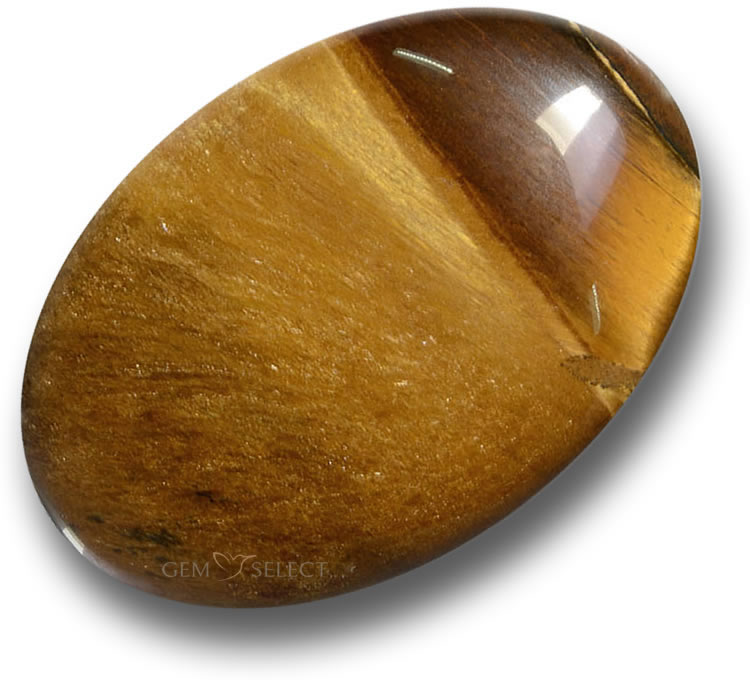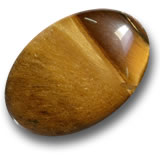Tiger's Eye Gemstone Information

Tiger's Eye is a striking gemstone known for its lustrous golden-brown tones and unique chatoyancy, which mimics the gleam in a tiger’s eye. As part of the quartz family, it forms when crocidolite (blue asbestos) is replaced by quartz crystals, leading to a vibrant, banded look. This creates a captivating band of light that shifts across the stone’s surface depending on how you view it. For more details on this fascinating gem, explore our Tiger's Eye overview.
Tiger's eye stands out for its remarkable chatoyancy and appealing golden brown shades. It's closely linked to hawk's eye and pietersite, which share similar shimmering effects. Interestingly, tiger's eye actually develops from hawk's eye. In this transformation, higher iron oxide content leads to the brownish hues of tiger's eye, while less oxidation keeps more of the original blue from crocidolite. Pietersite, technically, can refer to any brecciated form of tiger's eye or hawk's eye - meaning rocks broken apart, mixed, and then recemented by quartz or another matrix. This gives a more chaotic shimmer compared to the straight-line chatoyancy in standard hawk's eye and tiger's eye.

Identifying Tiger's Eye
You can spot tiger's eye by its distinct golden brown color, that eye-catching chatoyancy, and its silicon dioxide makeup. Like other quartz, it has solid hardness and durability, scoring 6.5 to 7 on the Mohs scale. It differs from hawk's eye with its browner shade and lower iron levels. Remember, tiger's eye forms from hawk's eye - as blue crocidolite gets replaced by chalcedony quartz, the fibers break down and iron oxidizes them. More oxidation means less blue remains. Learn more about its unique traits in our Tiger's Eye identification guide.
Tiger's Eye Origin and Sources
Tiger's eye appears in various spots worldwide, but the key suppliers today are Thailand and South Africa's Northern Cape. Other places include Australia, Brazil, Canada, China, India, Korea, Myanmar (Burma), Namibia, Spain, and the USA.
Buying Tiger's Eye and Determining Value
Tiger's Eye Color
Tiger's eye typically shows golden brown to brownish-gold tones. Some pieces with less iron might lean bluish. It's often multicolored with stripes in brown, black, or gold, and wavy patterns. The chatoyancy can make colors appear darker or lighter based on the angle.
Tiger's Eye Clarity and Luster
This stone is fibrous and opaque, with an attractive iridescence. The chatoyancy boosts its silky shine, especially in cabochon cuts. Even flat cuts reflect light rays. Some show a strong cat's eye effect as a single beam.
Tiger's Eye Cut and Shape
It's usually cut en cabochon to highlight the chatoyancy. Sometimes carved into flowers or animals. Rarely faceted. Common shapes include ovals, pears, rounds, freeforms, or beads for jewelry.
Tiger's Eye Treatment
Most tiger's eye isn't treated. Reddish ones might be dyed or heated for better color. Nitric acid can lighten dark tones rarely. Watch for imitations like fiber-optic glass, or honey-colored pieces sold as chrysoberyl cat's eye.
Tiger's Eye Gemological Properties
| Chemical Formula: | SiO2; Silicon dioxide |
|---|---|
| Crystal Structure: | Trigonal / hexagonal; fibrous aggregate |
| Color: | Gold-yellow, gold-brown |
| Hardness: | 6.5 to 7 on the Mohs scale |
| Refractive Index: | 1.534 to 1.540 |
| Density: | 2.58 to 2.64 |
| Cleavage: | None |
| Transparency: | Opaque |
| Double Refraction or Birefringence: | None |
| Luster: | Silky |
| Fluorescence: | None |
Please refer to our Gemstone Glossary for details of gemology-related terms.
Tiger's Eye Mythology, Metaphysical and Crystal Healing Properties
As a quartz family member, tiger's eye is linked to boosting physical strength and endurance. It's great for vision issues and sharpening focus. Some use it for eyesight, spine, neck problems, or sinus relief. In ancient times, warriors wore it for protection and courage. It's seen as a confidence stone for travelers and a shield against negative energy. Discover more in our Tiger's Eye metaphysical properties guide.
Disclaimer: Metaphysical and Alternative Crystal Healing Powers and Properties are not to be taken as confirmed advice. Traditional, Ceremonial and Mythological Gemstone Lore is collected from various resources and does not represent the sole opinion of SETT Co., Ltd. This information is not to replace the advice of your doctor. Should you have any medical conditions, please see a licensed medical practitioner. GemSelect does not guarantee any claims or statements of healing or astrological birthstone powers and cannot be held liable under any circumstances.
Tiger's Eye Gemstone and Jewelry Design Ideas
Though tiger's eye is somewhat rare globally, large deposits in South Africa and Thailand keep it affordable and popular for jewelry. It's durable like other quartz. Tiger's eye matrix works well for oversized rings or men's cabochons. Its golden brown appeals to men, often used in pendants, beaded necklaces, or rings. Beads are common, and carvings like flowers make nice pins or brooches.
The color, silky chatoyancy, and low cost draw designers. It's easy to shape, ideal for men's cuff-links or tie-tacks. Large sizes don't spike the price much, unlike other gems.
Note: Buy colored gemstones by size and not by carat weight. Colored stones vary in size-to-weight ratio. Some stones are larger and others are smaller than diamonds by weight in comparison.
Tiger's Eye Gemstone Jewelry Care and Cleaning

Like most quartz, tiger's eye holds up well but watch out for acids in household cleaners. Stick to warm water and mild soap. Skip bleach, ammonia, or sulfuric acid, and don't spray perfume or hairspray on it.
Ultrasonic and steam cleaners are usually okay for quartz, but be cautious - not always recommended for gems. Remove tiger's eye before sports, exercise, or chores like dishwashing. Store separately from other gems, wrapped in soft cloth or in a fabric-lined box.
Frequently Asked Questions
What is Tiger's Eye?
Tiger's Eye is a gemstone in the quartz family, known for its golden-brown colors and chatoyancy that resembles a tiger's gaze.
How is Tiger's Eye formed?
It forms through the replacement of crocidolite with quartz, creating banded patterns and shimmering effects.
Where does Tiger's Eye come from?
Main sources are Thailand and South Africa, with other deposits in Australia, Brazil, China, India, and more.
Is Tiger's Eye treated?
Usually not, but some reddish stones may be dyed or heated, and dark ones lightened with acid.
What are the healing properties of Tiger's Eye?
It's believed to aid strength, vision, and confidence, but these claims aren't scientifically proven - consult a doctor for health issues.


